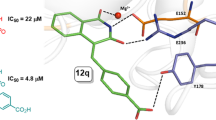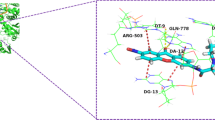Abstract
A series of derivatives of 3′,4′ 0,0-didemethylpodophyllotoxin have been synthesized and evaluated for their inhibitor activity against neoplastic cell growth (KB) and against human DNA topoisomerase II as well as for their activity in causing cellular protein-linked DNA breakage. The results show that the compounds possessing a 4β-anilino moiety either unsubstituted or substituted at the para (F, COOCH3, COCH3, CN, CH2CN, NO2) or meta (OH) positions or with an ethylenedioxy moiety showed the same or greater activity than etoposide in causing cellular protein-linked DNA breakage and in inhibiting DNA topoisomerase II. However, compared to the corresponding 4′-0-demethyl analogues, the 3′,4′-O,O-didemethyl compounds have a similar potency in inhibition of DNA topoisomerase II but are less active in causing cellular protein-linked DNA breakage. Complete correlation between the three biological activities–cytotoxicity, inhibition of DNA topoisomerase II, and induction of protein-linked DNA breakage–was also not observed. This supports the possibility that the biological determinants of action among these compounds may be different.
Similar content being viewed by others
REFERENCES
X. M. Zhou, Z. Q. Wang, H. X. Chen, Y. C. Cheng, and K. H. Lee. Antitumor agents 125: New 4β-benzoylamino and 4β-benzoyl derivatives of 4′O-demethylpodophyllotoxin as potent inhibitors of human DNA topoisomerase II. Pharm. Res. 10:214–219 (1993).
I. Jardine, In J. M. Cassady and J. D. Douros (eds.), Anticancer Agents Based on Natural Product Models, Academic Press, New York, 1980, pp. 319–351.
B. F. Issell, F. M. Muggia, and S. K. Carter. Etoposide [VP-16] Current Status and New Developments, Academic Press, Orlando, FL, 1984, pp. 1–355.
H. Stahelin and A. von Wartburg. From podophyllotoxin glucoside to etoposide. In E. Jucker (Ed.), Progress in Drug Research, Birkhauser Verlag, 1989, Vol. 33, pp. 169–266.
W. Ross, T. Rowe, B. Glisson, J. Yalowich, and L. Liu. Role of topoisomerase II in mediating epipodophyllotoxin-induced DNA. Cancer Res. 44:5857–5860 (1984).
K. M. Tewey, G. L. Chen, E. M. Nelson, and L. F. Liu. Intercalative antitumor drugs interfere with the breakage-reunion reactions of mammalian DNA topoisomerase II. J. Biol. Chem. 259:9182–9187 (1984).
E. M. Nelson, K. M. Tewey, and L. F. Liu. Mechanism of antitumor drug action: Poisoning of mammalian DNA topoisomerase II on DNA by 4′-(9-acridinylamino)-methanesulfon-m-anisidide. Proc. Natl. Acad. Sci. USA 81:1361–1365 (1985).
J. D. Loike and S. B. Horwitz. Effect of VP-16-213 on the intracellular degradation of DNA in HeLa cells. Biochemistry 15:5443–5448 (1976).
A. H. Wozniak and W. E. Ross. DNA damage as a basis for 4′-demethylepipodophyllotoxin-9-(4,6-O-ethylidene-β-D-glucopyranoside) (etoposide) cytotoxicity. Cancer Res. 43:120–124 (1983).
B. K. Sinha and C. E. Myers. Irreversible binding of etoposide (VP-16) to deoxyribonucleic acid and proteins. Biochem. Pharmacol. 33:3725–3728 (1984).
B. K. Sinha, M. A. Trush, and B. Kalyanaraman. Microsomal interactions and inhibitions of lipid peroxidation by etoposide (VP-16,213): Implications for mode of action. Biochem. Pharmacol. 34:2036–2040 (1985).
N. Haim, J. Roman, J. Nemec, and B. K. Sinha. Peroxidative free radical formation and O-demethylation of etoposide (VP-16) and teniposide (VM-26). Biochem. Biophys. Res. Commun. 135:215–220 (1986).
N. Haim, J. Nemec, J. Roman, and B. K. Sinha. In vitro metabolism of etoposide (VP-16-213) by liver microsomes and irreversible binding of reactive intermediates to microsomal proteins. Biochem. Pharmacol. 36:527–536 (1987).
J. M. S. van Maanen, E. Akker, J. D. Vries, T. R. Bakkenist, J. Lankelma, J. Retel, and H. M. Pinedo. Structure-bioactivation relationship of a series of podophyllotoxin derivatives. Eur. J. Clin. Oncol. 24:1415 (1988).
N. Haim, J. Nemec, J. Roman, and B. K. Sinha. Peroxidase-catalyzed metabolism of etoposide (VP-16-213) and covalent binding of reactive intermediates to cellular macromolecules. Cancer Res. 47:5835–5840 (1987).
J. M. S. van Maanen, J. D. Vries, D. Pappie, E. Akker, M. V. Lafleur, J. Retel, J. Greef, and H. M. Pinedo. Cytochrome P-450 medicated O-demethylation: A route in the metabolic activation of etoposide (VP-16-213). Cancer Res. 47:4658 (1987).
J. M. S. van Maanen, C. D. Ruiter, J. D. Vries, P. R. Koostra, F. Gobas, and H. M. Pinedo. The role of metabolic activation by cytochrome P-450 in covalent binding of VP-16-123 to rat liver and HeLa cell microsomal proteins. Eur. J. Cancer Clin. Oncol. 21:1099 (1985).
B. Kalyanaraman, J. Nemec, and B. K. Sinha. Characterization of free radicals produced during oxidation of etoposide (VP-16) and its catechol and quinone derivatives. An ESR study. Biochemistry 28:4839–4846 (1989).
H. Sakurai, T. Miki, Y. Imakura, M. Shibuya, and K. H. Lee. Metal-and photo-induced cleavage of DNA by podophyllotoxin, etoposide, and their related compounds. Mol. Pharmacol. 40:965 (1991).
L. Thurston, H. Irie, S. Tani, F. S. Han, Z. C. Liu, Y. C. Cheng, and K. H. Lee. Antitumor agents 78. Inhibition of human DNA topoisomerase II by podophyllotoxin and α-peltatin analogues. J. Med. Chem. 29:1547–1550 (1986).
S. A. Beers, Y. Imakura, H. J. Dai, Y. C. Cheng, and K. H. Lee. Antitumor agents 99. Synthetic ring C aromatized podophyllotoxin analogues as potential inhibitors of human DNA topoisomerase II. J. Nat. Proc. 51:901–905 (1988).
L. S. Thurston, Y. Imakura, M. Haruna, D. H. Li, Z. C. Kiu, S. Y. Liu, Y. C. Cheng, and K. H. Lee. Antitumor agents 100. Inhibition of human DNA topoisomerase II by cytotoxic ether and ester derivatives of podophyllotoxin and α-peltatin. J. Med. Chem. 32:604–608 (1989).
K. H. Lee, Y. Imakura, M. Haruna, S. A. Beers, L. S. Thurston, H. J. Dai, C. H. Chen, S. Y. Liu, and Y. C. Cheng. Antitumor agents 107. New cytotoxic 4-alkylamino analogues of 4′-demethylepipodophyllotoxin as inhibitors of human DNA topoisomerase II. J. Nat. Prod. 52:606–613 (1989).
S. Y. Liu, B. D. Hwang, M. Haruna, Y. Imakura, K. H. Lee, and Y. C. Cheng. Podophyllotoxin agents: Effects on DNA topoisomerase II, tubulin polymerization, human tumor KB Cells, and their VP-16-resistant variants. Mol. Pharmacol. 36:78–82 (1989).
K. H. Lee, S. A. Beers, M. More, Z. Q. Wang, Y. H. Kuo, L. Li, S. Y. Liu, J. Y. Chang, F. S. Han, and Y. C. Cheng. Antitumor agents 111. New 4-hydroxylated and 4-halogenated anilino derivatives of 4′-demethylepipodophyllotoxin as potent inhibitors of human DNA topoisomerase II. J. Med. Chem. 33:1364–1368 (1990).
Z. Q. Wang, Y. H. Kuo, D. Schnur, J. P. Bowen, S. Y. Liu, F. S. Han, J. Y. Chang, Y. C. Cheng, and K. H. Lee. Antitumor agents 113. New 4β-arylamino derivatives at 4′-O-demethylepipodophyllotoxin and related compounds as potent inhibitors of human DNA topoisomerase II. J. Med. Chem. 33:2660–2666 (1990).
J. Y. Chang, F. S. Han, S. Y. Liu, Z. Q. Wang, K. H. Lee, and Y. C. Cheng. Effect of 4β-arylamino derivatives of 4′-O-demethylepipodophyllotoxin on human DNA topoisomerase II, tubulin polymerization, KB cells, and their resistant variants. Cancer Res. 51:1755–1759 (1991).
Z. Q. Wang, H. Hu, H. X. Chen, Y. C. Cheng, and K. H. Lee. J. Med. Chem. 35:871–876 (1992).
D. C. Ayres and C. K. Lim. Modifications of the pendant ring of podophyllotoxin. Cancer Chemother. Pharmacol. 7:99–101 (1982).
M. Kuhn and A. von Wartburg. Synthesis and antimitotic activity of glycosidic lignan derivatives related to podophyllotoxin. J. Med. Chem. 14:936–940 (1971).
Author information
Authors and Affiliations
Rights and permissions
About this article
Cite this article
Wang, ZQ., Shen, YC., Chen, HX. et al. Antitumor Agents 126. Novel 4β-Substituted Anilino Derivatives of 3′,4′ -O, O-Didemethylpodophyllotoxin as Potent Inhibitors of Human DNA Topoisomerase II. Pharm Res 10, 343–350 (1993). https://doi.org/10.1023/A:1018923902760
Issue Date:
DOI: https://doi.org/10.1023/A:1018923902760




